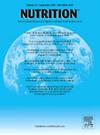Excessive dietary saturated fat or fructose and their combination (found in ultra-processed foods) impair mitochondrial dynamics markers and cause brown adipocyte whitening in adult mice
IF 3.2
3区 医学
Q2 NUTRITION & DIETETICS
引用次数: 0
Abstract
Objective
To investigate the effects of comparable dietary excess of fat or fructose and the combination of these two insults (mimicking ultra-processed foods) on interscapular brown adipose tissue (iBAT) whitening and markers of mitochondrial dynamics in adult male mice.
Methods
Male C57BL/6 mice were randomly assigned into four groups according to the diet: control diet (C, following AIN-93M), high-fat diet (HF, 32% energy as lard), high-fructose diet (HFRU, 32% energy as fructose) or for high-fat/high-fructose diet (HF-HFRU, 32% as lard and 32% as fructose) for 12 weeks. Data were tested with one-way ANOVA and Dunnet T3 post-test (n=5 per analysis, significance level P < 0.05).
Results
All diets caused insulin resistance and iBAT whitening, albeit with overweight only in the HF and HF-HFRU groups. Principal component analysis indicated that the HFRU scores loaded next to inflammation (Nlrp3) and adipogenesis markers (Pparg), and the HF diet influenced more a mitochondrial gene (Tomm20). However, iBAT whitening in all groups was associated with deficits in mitochondrial dynamics (Ppargc1a, Dnml1, and Pink1), vascularization (Vegfa), and thermogenic markers (Bmp8b, and Ucp1).
Conclusion
Similar increases in dietary saturated fat or fructose (32% as energy) and the combination of these two insults (32% / 32%) caused insulin resistance and brown adipocyte dysfunction (whitening) in adult mice after 12 weeks independent of being overweight. In comparison, the PC scores of the HFRU groups were closer to the HF-HFRU group than the HF group, implying a worse outcome and highlighting the importance of limiting saturated fat and fructose intake from ultra-processed foods.
过量的饮食饱和脂肪或果糖及其组合(在超加工食品中发现)损害线粒体动力学标记并导致成年小鼠棕色脂肪细胞变白
目的探讨脂肪或果糖的过量摄入及其复合(模拟超加工食品)对成年雄性小鼠肩膜间棕色脂肪组织(iBAT)白化和线粒体动力学标志物的影响。方法将C57BL/6小鼠按日粮随机分为4组:对照日粮(C, AIN-93M)、高脂日粮(HF,能量32%为猪油)、高果糖日粮(HFRU,能量32%为果糖)或高脂/高果糖日粮(HF-HFRU,能量32%为猪油和32%为果糖),为期12周。数据采用单因素方差分析和Dunnet T3后验(每次分析n=5,显著性水平P <;0.05)。结果所有饮食均引起胰岛素抵抗和iBAT增白,但只有HF和HF- hfru组出现超重。主成分分析表明,HFRU评分与炎症(Nlrp3)和脂肪生成标志物(Pparg)并列,而HF饮食对线粒体基因(Tomm20)的影响更大。然而,所有组的iBAT美白都与线粒体动力学(Ppargc1a、Dnml1和Pink1)、血管化(Vegfa)和产热标志物(Bmp8b和Ucp1)的缺陷有关。结论在独立超重的情况下,12周后,饱和脂肪或果糖(32%作为能量)的类似增加以及两者的联合(32% / 32%)可引起成年小鼠胰岛素抵抗和棕色脂肪细胞功能障碍(变白)。相比之下,HFRU组的PC评分更接近HF-HFRU组,这意味着结果更差,并强调了限制从超加工食品中摄入饱和脂肪和果糖的重要性。
本文章由计算机程序翻译,如有差异,请以英文原文为准。
求助全文
约1分钟内获得全文
求助全文
来源期刊

Nutrition
医学-营养学
CiteScore
7.80
自引率
2.30%
发文量
300
审稿时长
60 days
期刊介绍:
Nutrition has an open access mirror journal Nutrition: X, sharing the same aims and scope, editorial team, submission system and rigorous peer review.
Founded by Michael M. Meguid in the early 1980''s, Nutrition presents advances in nutrition research and science, informs its readers on new and advancing technologies and data in clinical nutrition practice, encourages the application of outcomes research and meta-analyses to problems in patient-related nutrition; and seeks to help clarify and set the research, policy and practice agenda for nutrition science to enhance human well-being in the years ahead.
 求助内容:
求助内容: 应助结果提醒方式:
应助结果提醒方式:


